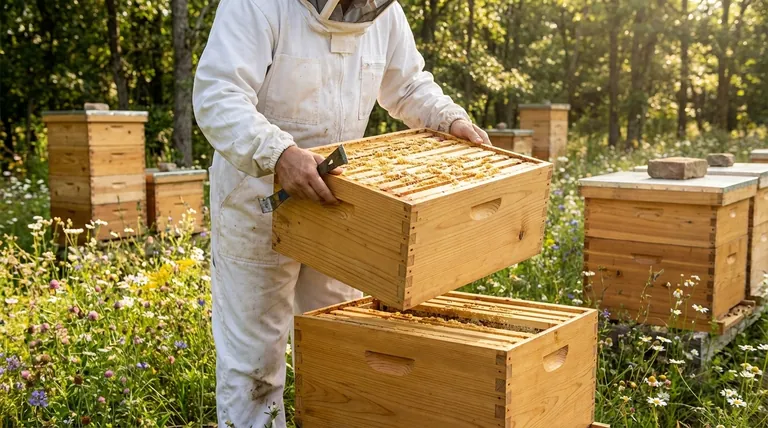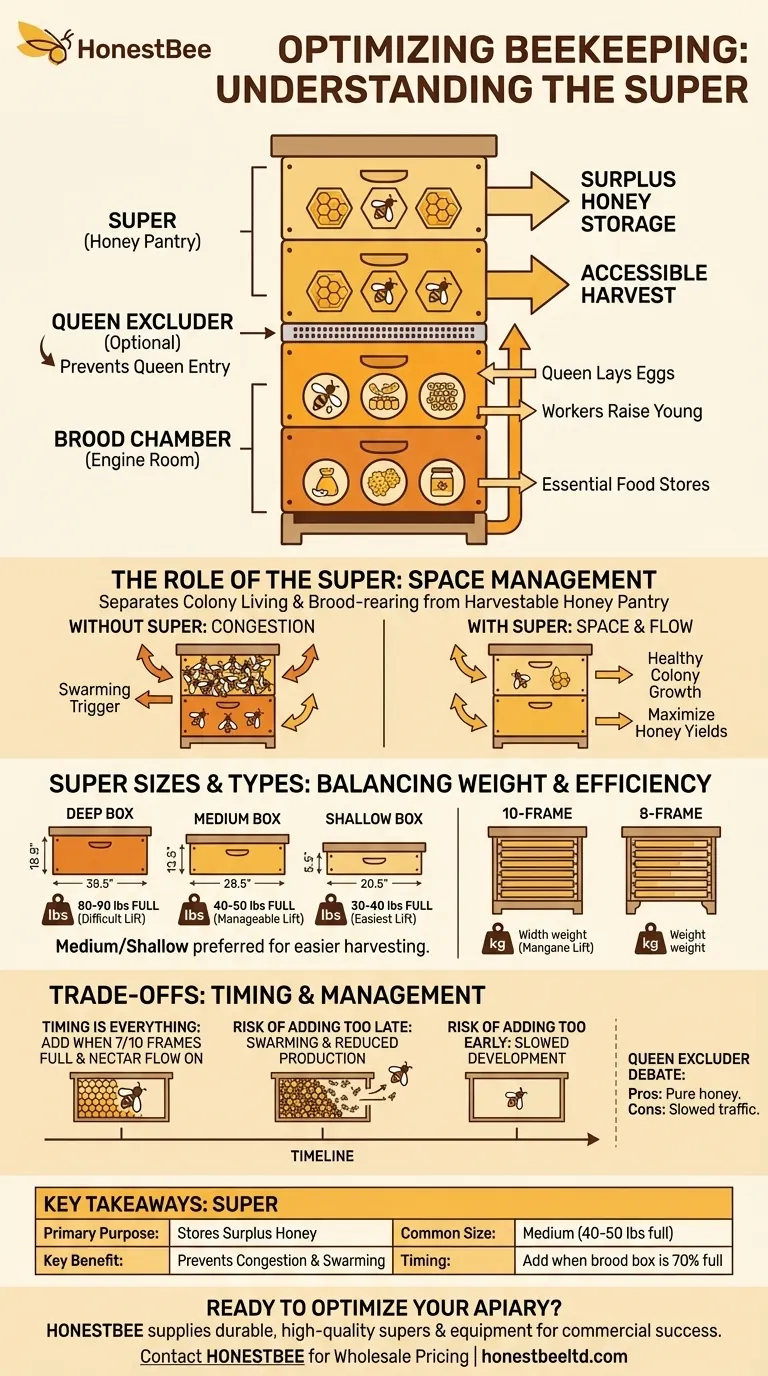In beekeeping, a super is simply a box containing frames that is placed on top of the main hive body. Its specific purpose is to give the honeybee colony additional space to store surplus honey, particularly during a strong nectar flow. This allows the beekeeper to harvest honey without taking the essential food stores the bees need to survive in their primary living quarters.
The core concept is not just about the box itself, but about managing space. Supers allow a beekeeper to separate the colony's living and brood-rearing area from the "pantry" where excess, harvestable honey is stored.

The Role of the Super in a Beehive
A modern Langstroth beehive is a modular, multi-story structure. Understanding the function of each "story" or box is fundamental to managing a colony.
The Brood Box: The Heart of the Colony
The bottom box, or boxes, of the hive is called the brood chamber or brood box. This is the engine room of the colony.
Here, the queen lays her eggs, and the worker bees raise the young (the brood). The brood box also contains the pollen and honey stores essential for the colony's immediate survival and for feeding the developing bees.
The Super: The Honey Pantry
The super (short for superstructure) is any box placed on top of the brood chamber. Its function is to hold the honey that the bees produce beyond what they need for their own survival.
When the brood box is full and nectar is abundant, the bees will naturally begin storing honey in any available space above them. By adding a super, the beekeeper provides this space in a controlled, accessible way.
Why Separation is Key
This separation is critical. It allows the beekeeper to remove and extract honey from the supers with confidence, knowing that the brood nest remains undisturbed and the colony retains its vital food reserves in the brood chamber below.
Understanding Super Sizes and Types
While any hive box can technically be used as a super, certain sizes are used for specific, practical reasons. Hive boxes are defined by their height and the number of frames they hold.
Deep vs. Medium vs. Shallow
The three standard box heights are deep, medium, and shallow.
- Deep Boxes: These are the largest and are typically used for the brood chamber because they provide ample space for the queen's laying pattern.
- Medium & Shallow Boxes: These are most commonly used as supers. Their smaller size is their primary advantage.
The Importance of Weight
A deep box full of honey can weigh 80-90 pounds (36-41 kg), making it extremely difficult and dangerous to lift.
A medium super, by contrast, weighs a more manageable 40-50 pounds (18-23 kg) when full. This is the single biggest reason most beekeepers prefer using medium or shallow boxes for honey collection.
10-Frame vs. 8-Frame Equipment
Hives also come in two standard widths: 10-frame and 8-frame. An 8-frame hive is slightly narrower and lighter than a 10-frame hive. The choice of super must match the hive body; you use an 8-frame super on an 8-frame hive.
The Trade-offs: When and How to Add a Super
Using a super isn't just about placing a box on a hive; it's a management decision with important timing considerations.
Timing is Everything
A super should be added when the bees are beginning to fill the top box of the hive and a nectar flow (a period of high nectar availability from blooming plants) is underway.
Adding a super too early creates a large empty space that the bees must patrol and keep warm, potentially slowing colony development, especially in cooler weather.
The Risk of Adding a Super Too Late
Waiting too long to add a super is a classic beginner mistake. When bees run out of space to store incoming nectar and the queen runs out of room to lay eggs, they feel congested.
This feeling of congestion is a primary trigger for swarming, where the old queen leaves with roughly half the colony to find a new home. Adding a super in time provides necessary space and can help prevent swarming.
The Queen Excluder Debate
Some beekeepers place a queen excluder, a flat screen with gaps large enough for worker bees but too small for the queen, between the brood box and the supers. This ensures no eggs are laid in the honey supers.
However, others argue that excluders can slow down worker bee traffic, potentially reducing the amount of honey stored. The decision to use one is a common trade-off in beekeeping management.
Making the Right Choice for Your Goal
Your approach to using supers will depend on your beekeeping philosophy and physical ability.
- If your primary focus is easier lifting and harvesting: Standardize on medium supers for all your honey collection.
- If your primary focus is simplifying your equipment: Use all medium boxes for both brood and supers, so all your frames and boxes are interchangeable.
- If your primary focus is preventing swarms: Add your first super when the bees have drawn out comb on about 7 of the 10 frames in their top brood box.
Understanding the super transforms it from a simple box into a powerful tool for managing your colony's growth and honey production.
Summary Table:
| Aspect | Key Takeaway |
|---|---|
| Definition | A box placed on top of the brood chamber for storing surplus honey. |
| Primary Purpose | Separates harvestable honey from the colony's essential living and brood-rearing area. |
| Common Sizes | Medium and shallow supers are preferred for their manageable weight (40-50 lbs when full). |
| Key Benefit | Provides space to prevent colony congestion, a primary trigger for swarming. |
| Timing | Add a super when bees have filled about 7 out of 10 frames in the top brood box during a nectar flow. |
Ready to Optimize Your Apiary?
As a commercial beekeeper or equipment distributor, efficient hive management is key to your success. HONESTBEE supplies the durable, high-quality supers and beekeeping equipment you need to scale your operations and maximize honey yields.
We understand the trade-offs between weight, space, and bee behavior. Let us help you choose the right equipment—from 8-frame or 10-frame setups to medium supers—to keep your colonies productive and prevent swarming.
Contact HONESTBEE today for wholesale pricing on reliable beekeeping supplies and expert support tailored to commercial operations.
Visual Guide

Related Products
- Langstroth Honey Bee Box Hive Boxes for Different Depths
- Australian Langstroth Beehive Boxes for Beekeeping Wholesales
- Professional 500g Sectional Comb Honey Frame System for Beekeeping
- Portable Bee Mating Hive Boxes Mini Mating Nucs 8 Frames for Queen Rearing
- Automatic Heat Preservation 6 Frame Pro Nuc Box for Honey Bee Queen Mating
People Also Ask
- What are the sizes available for Langstroth boxes? A Guide to 8-Frame vs. 10-Frame & Depths
- How is checking honey supers in a Langstroth hive different from inspecting Honey Flow supers? A Guide to Disruptive vs. Non-Invasive Methods
- How should hive boxes be aligned after reassembly? Ensure a Perfect Seal for Hive Health
- Why do you need two bee hives? Boost Your Apiary's Success with Smart Risk Management
- What is the purpose of the boxes in a Langstroth hive? A Guide to Modular Beekeeping Success



















